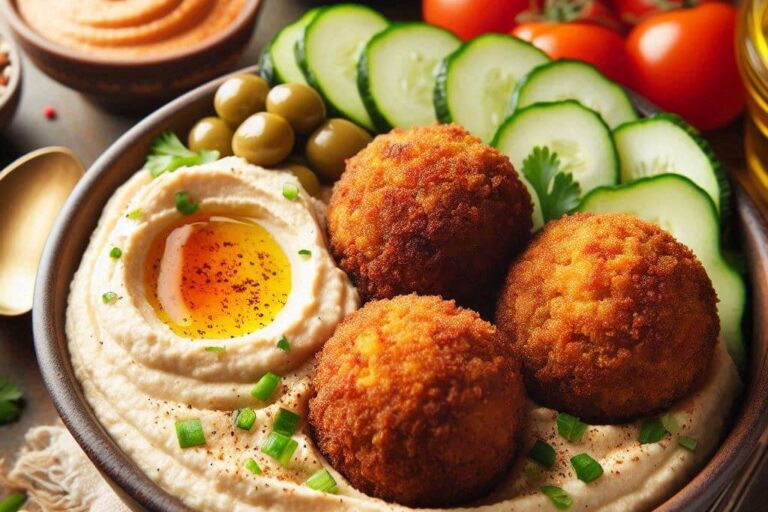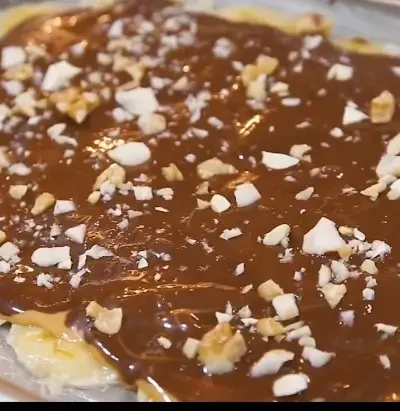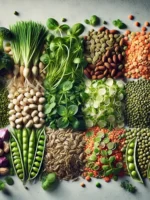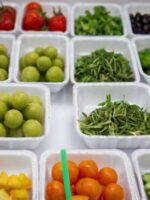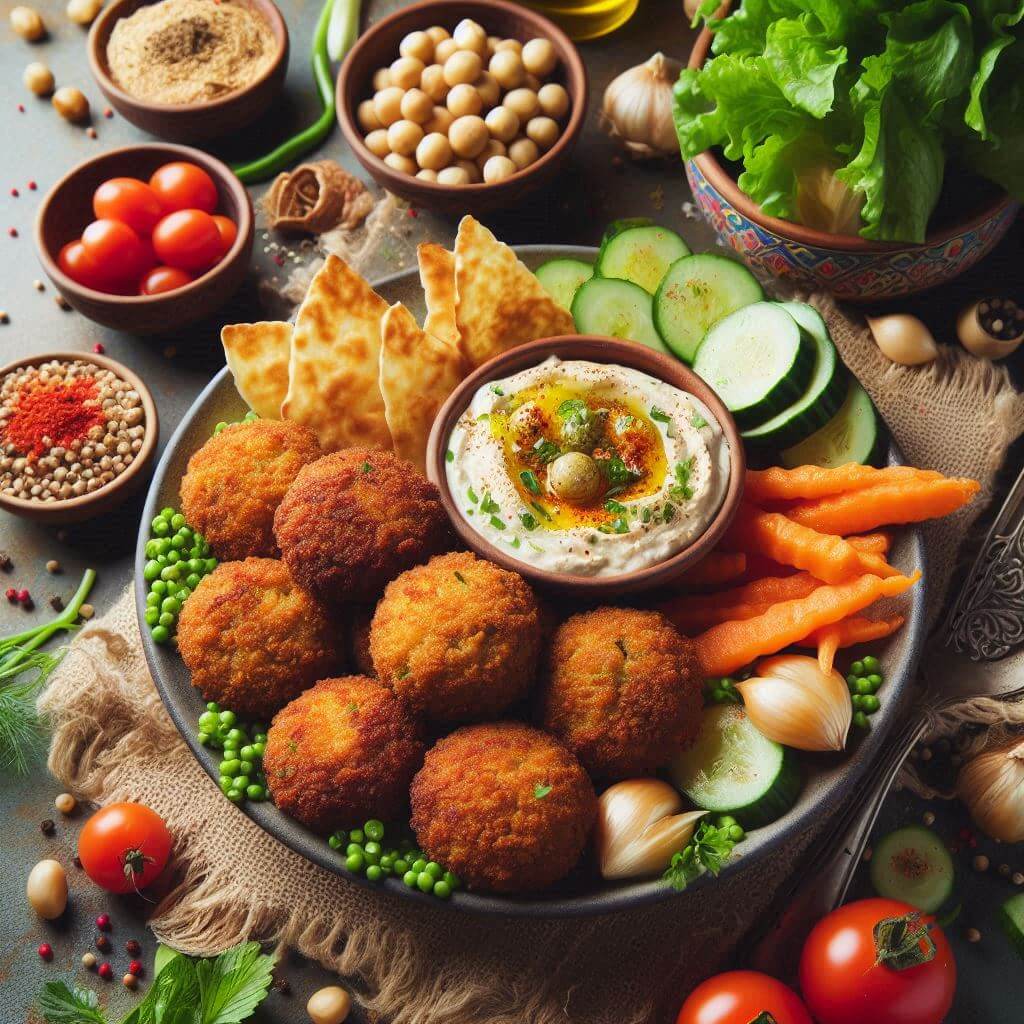
learn the art of falafel and hummus from a local vendor.
He patiently taught us the secrets of grinding chickpeas, the importance of balancing spices and the technique for perfect frying.
After a lot of practice and some tweaking, we came up with this recipe, which captures the essence of that special day in Jordan.
We hope that by making it, you too can enjoy a little taste of the Middle East and create delicious memories in your own kitchen.
Detailed Extra Info: A Complete Falafel and Hummus Journey
In this section, we go beyond the basic recipe, delving into a world of extra information to enhance your culinary experience with crispy falafel and creamy hummus.
Discover everything from valuable tips for impeccable preparation to interesting facts about the origin and history of these ancient dishes.
Preparation Time:
- Total: 1 hour and 30 minutes (including time to soak the chickpeas)
- Falafel Preparation: 1 hour (including 30 minutes of rest of the dough in the refrigerator)
- Grind the chickpeas: 10 minutes
- Process the ingredients and season: 15 minutes
- Shaping the dumplings: 15 minutes
- Frying the falafel: 20 minutes
- Hummus Preparation: 30 minutes
- Process the ingredients: 15 minutes
- Adjust the seasoning and finish: 15 minutes
- Falafel Preparation: 1 hour (including 30 minutes of rest of the dough in the refrigerator)
- Notes:
- Preparation time may vary depending on your practice and utensils used.
- Plan ahead for the time to soak the chickpeas (minimum 8 hours).
Performance:
- 4 generous servings
- Perfect for a complete snack, a tasty starter or even a vegetarian main course.
- Adapt the quantity according to your appetite and the number of people you want to serve.
Tips for Perfect Falafel:
- Chickpea:
- Use good quality dried chickpeas for a flawless result.
- Wash and dry the chickpeas well before soaking them.
- The ideal soaking time is 8 hours, but you can soak it for up to 12 hours for a more intense flavor.
- Grinding:
- Grind the chickpeas until you get a thick, smooth paste.
- Use a powerful food processor to ensure a uniform texture.
- If necessary, add a little water to facilitate grinding.
- Spices:
- Adjust the amount of spices according to your taste.
- Experiment with different spice combinations to create a unique flavor for your falafel.
- Some spices that go well with falafel: hot paprika, chili pepper, nutmeg, ground cumin, ground coriander, etc.
- Modeling:
- With damp hands, shape the falafel dough into flat, round balls.
- If the dough is too wet, add a little wheat flour.
- If the dough is too dry, add a little water.
- Frying:
- Heat the oil in a deep pan over medium heat (about 180°C).
- Fry the falafel in the hot oil until golden brown on all sides, about 3-4 minutes.
- Do not overcrowd the pan as this can lower the temperature of the oil and result in greasy, undercooked falafel on the inside.
- Drain the falafel on paper towels to remove excess oil.
- Extra tips:
- For a crispier falafel, use sunflower oil or canola oil.
- If you don't have a cooking thermometer, to check if the oil is at the right temperature, drop a small piece of falafel dough into the oil. If the piece floats immediately and browns quickly, the oil is ready.
- You can also bake the falafel instead of frying it. Preheat the oven to 200°C, arrange the dumplings on a greased baking sheet and bake for 20-25 minutes, turning them halfway through.
Tips for a Creamy and Irresistible Hummus:
- Chickpea:
- Use good quality cooked chickpeas.
- You can cook chickpeas at home or use canned cooked chickpeas (no salt added).
- If using home-cooked chickpeas, drain them and reserve the cooking water. The cooking water can be used to adjust the consistency of the hummus if necessary.
- Girl:
- Tahini is a paste made from toasted and ground sesame seeds, the main ingredient in hummus.
- Choose fresh, good quality tahini for the best flavor.
- The amount of tahini can be adjusted to your preference. More tahini results in a thicker hummus with a more pronounced sesame flavor.
- Water:
- The chickpea cooking water (if using) or fresh filtered water is used to adjust the consistency of the hummus.
- Add water little by little, tablespoon by tablespoon, until you get the desired creamy texture.
- It is important to be careful not to make the hummus too soft.
- Lemon:
- Fresh lemon juice adds freshness and acidity to the hummus.
- Adjust the amount of lemon juice according to your taste and the desired level of acidity.
- Spices:
- In addition to ground cumin and salt, you can try adding other seasonings to your hummus, such as smoked paprika, freshly ground black pepper, garlic powder, or extra virgin olive oil.
- Storage:
- Homemade hummus can be stored in the refrigerator in an airtight container for up to 3 days.
- Before serving, mix the hummus well to redistribute the oil.
A Dive into History: The Origin of Falafel and Hummus
Falafel and hummus are dishes that originated in the Middle East, with a rich and ancient history. Although their exact origins are uncertain, evidence suggests that both dishes have been consumed in the region for centuries.
- Falafel:
- Falafel is believed to have originated in Ancient Egypt, possibly as an alternative to meat.
- Traditional falafel is made with chickpeas, but variations with other legumes such as fava beans and lentils are also found in different regions of the Middle East.
- Hummus:
- Hummus has an even older history, with records of its consumption in Mesopotamia over 2,000 years ago.
- It was a popular food among different civilizations in the region, appreciated for its nutritional value and flavor.
Beyond the Recipe: A Cultural Celebration
Over time, falafel and hummus have become iconic foods in Middle Eastern cuisine, crossing borders and conquering palates around the world.
Today, these dishes are found in Arabic restaurants, street stalls and home kitchens across the globe.
Making falafel and hummus at home is more than just following a recipe. It’s an opportunity to connect with Middle Eastern culture and tradition.
It is a sensory journey that allows you to appreciate the aroma of spices, the texture of chickpeas and the explosion of flavors in your mouth.
So, let’s get started! Put on your apron, gather your ingredients and embark on this culinary adventure. Prepare your own crispy falafel and creamy hummus, and celebrate the magic of Middle Eastern cuisine in your own kitchen!
Ending with a Smile
“Life is like a recipe: full of flavors, colors and stories waiting to be savored. Try something new today and discover the magic that lies beyond the plate.”

